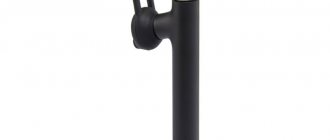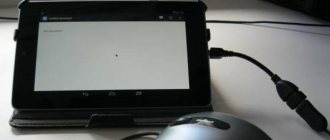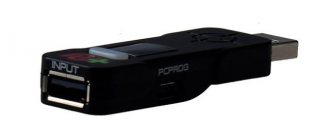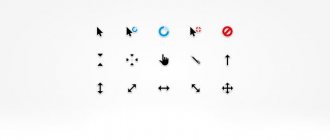Hi all! Today we will look at which mouse is better - optical or laser, what is the difference between them, what is the internal structure of each device and what is better for games. For a better understanding of the topic, I also advise you to read about the history of the first computer mouse.
How an optical mouse works
In essence, a modern computer manipulator with an optical sensor is the same camera, but with a low-resolution matrix. The most common sensor type is 30 x 30 pixels.
From this article you will learn:
- How an optical mouse works
- How a laser mouse works
- Sensitivity and accuracy
- Other Features
- How to distinguish between the two types of mice
The design also contains a lighting source (red LED) and two lenses. The LED is installed at an angle to the working surface. The reflected beam is received by the CMOS sensor.
The size of the captured surface is measured in dots per inch and is called DPI. The sensor continuously removes the work surface. The conclusion about mouse movement is made based on a comparison of different consecutive images.
These signals are processed by the computer processor, which understands in which direction the cursor should move.
Mice: optical sensor
- Introduction
- Rugs
- Tear-off height
- Stall speed
- Instability
- Frame Rate
- DPI switch
Today we will talk about mice, but for now let's start with mouse pads. Normal heroes always take a detour
(from the film 'Aibolit 66'). There are many types and designs of mouse pads. They can have a working surface made of fabric, soft or hard plastic, or metal. The first option is the cheapest and, oddly enough, one of the best. For soft plastic, and for hard plastic too, there are options for optical and laser mice.
For the tests we used the usual Nova MicrOptic+ and Defender Ergo opti-laser mats. They have approximately the same appearance:
According to both manufacturers, these mats are optimized to work with laser mice. Let's check.
First, zoom-in shots of the surface:
announcements and advertising
2080 Super Gigabyte Gaming OC for 60 rubles.
Compeo.ru - the right comp store without any tricks
RTX 2060 becomes cheaper before the arrival of 3xxx
Ryzen 4000
series included in computers already in Citylink
The price of MSI RTX 2070 has collapsed after the announcement of RTX 3xxx
Core i9 10 series is half the price of the same 9 series
The price of memory has been halved in Regard - it’s more expensive everywhere
There are some differences, but not particularly noticeable. The Nova mat has smaller grains and is not as pronounced. Does that mean he's worse?
Now let's look at the rugs through the eyes of the optical sensor:
Agree that there are differences that are quite dramatic. The Nova's carpet has a clearly visible high-contrast structure, but the Defender's gave some kind of 'soap'. This is most likely due to the size of the 'granules'. Laser sensors, unlike optical sensors, have a reduced visible window size. It seems that on the Defender mat the granules are larger than the window and the sensor only captures part of them, constantly switching between monotonously light and dark areas. For comparison, here are photographs of the plastic surface.
The right image is obtained from the left one by increasing the contrast. The mouse sees this surface like this:
On such a surface, 'office' optical mice do not work at all, but laser mice somehow manage to work quite successfully.
What do you do when the mouse reaches the edge of the mousepad? You lift the mouse and move it to a new place, in the center of the mousepad. The optical sensor is highly sensitive and, when rising, tries to maintain normal functioning by constantly adjusting the equipment parameters. As a result, when the mouse rises above the surface, the speed decreases. More precisely, the speed does not decrease, but the quality and reliability of motion detection drops quite sharply. Theoretically, when the quality of the surface decreases below reasonable levels, the optical sensor should stop detecting movement. That is, when the mouse is raised a little, he should not notice that the mouse has been raised, and if he raises it even a little more, then he should simply stop transmitting the movement. This is ideal, but in real mice, as the surface deteriorates, the quality of movement transmitted by the mouse degrades. Moreover, this harmful effect depends on the speed of movement, which makes it more difficult to get used to such a mouse.
The lift-off height of LED mice is 1.5-2 mm; for laser versions the figure is higher and is already 2.5-4 mm. These are all numbers, but in reality such a mouse is inconvenient to use even for office applications; you have to lift it very high above the mat. According to my personal impressions, a stall height of 1.5-2 mm is quite comfortable. But what to do with laser mice and their stall height of 4 mm?
Let's grab one by the tail and look at the insides. Nowadays, mice based on the Avago sensor are common (link to https://www.avagotech.com) ADNS-6010
In order not to be too clever, I took a picture from the documentation.
Explanations:
- Sensor
- ADNS-6010 chip, which is a sensor that reads movement - Sensor PCB
- mouse printed circuit board - VCSEL
is a laser emitter. Just a small semiconductor laser with a mediocre beam angle. - VCSEL PCB
is a small printed circuit board on which the laser is mounted. - VCSEL Clip
is a plastic latch that secures the laser in the optical system. In the picture it is light yellow. - Lens
is an optical system made of transparent plastic, faded yellow. - Surface
- the surface on which the mouse moves.
This figure shows the figure 2.4 mm - this is the optimal distance from the bottom of the optical system to the surface. One point - the bottom of the mouse has some thickness, so the distance from the surface to the bottom of the mouse will be less by the thickness of this bottom.
What does the lift-off height depend on and why is this height smaller on optical mice? Let's look at another picture:
I took the liberty of painting some important design elements.
The lenses of the optical system are highlighted in yellow, and the laser luminous flux is highlighted in gray. Green—visibility range of the optical sensor. The sensor's 'visibility' area is determined only by its focus and its ability to work with an out-of-focus image. The higher the speed of movement of the picture, the worse the stability for unfocused objects should be. If you look at the testing data, it turns out that way. The stall height of 4 mm is not functional, I tried to reduce this value by slightly changing the principle of operation - loss of image by the sensor can be achieved not due to deterioration in focusing, but due to the light spot leaving the sensor’s visibility zone. This is roughly how LED mice work. To do this, I increased the angle of the backlight beam from 21 degrees to approximately 50 degrees from vertical.
When you lift the mouse, the backlight spot (gray beam) comes out of the visible sensor window (green zone).
The modification technique is not particularly difficult - you need to cut the optical block along a vertical line and not touch the lenses. In extreme cases, you can slightly damage the backlight lens, it is not so important. You can fasten the two components together with hot-melt glue, marked in brown in the figure.
It has sufficient rigidity and strength of the connection, while allowing for repeated correction of the position of the glued parts of the optics. When tilting the backlight, part of its structure will extend beyond the dimensions of the optics unit and will have to be filed down a little, marked in blue in the figure.
Unfortunately, the illumination unit must not only be tilted, but also moved downwards, due to which the illumination lens will be lower than the level of the optics. This is bad; in the bottom of the mouse you will have to melt a small dent under the protrusion. However, this is not difficult and does not interfere, because the lens extends just a little beyond the dimensions. The laser module was secured to the optics using a VCSEL Clip. Now it will have to be removed and secured with a drop of glue or sealant. Although, he's holding up pretty well there anyway. This design has one feature - the illumination beam falls on the surface at a different angle than the viewing angle of the sensor. As a result, an angle of about 15 degrees is formed between the surface plane and the reflection plane.
Black is a beam on an unmodified optical system, green is after modification. The surface for the modified case is conditionally raised so that it does not merge with the normal mode. The sensor looks from the side at the surface and sees all the irregularities on it more clearly. The additional tilt of the backlight provides additional brightness modulation when passing volumetric areas under the lens. Whether this is good or bad depends on the rug and the texture of its surface. By the way, if you take pictures of the surface of the Nova mousepad on this modified mouse, then the photo will not have such clear edges. And, most likely, it's not a matter of focusing. The angle of view simply changed and the clear structures of the rug disappeared. The Nova and Defender mouse pads look almost identical on this mouse. However, the mouse walks well on both surfaces. Unfortunately, there is an obvious drawback - due to the fact that the reflection surface is inclined relative to the surface of the mat, the overall level of illumination decreases and it becomes necessary to increase the backlight laser current. Usually it is around eight milliamps. After modification, I had to increase the current to 12 milliamps. This is already a bit much, but within the limits of what is affordable.
If you are modifying a regular, serial mouse, then it would be nice to have some help from an automatic laser current control circuit. The documentation for the ADNS-6010 sensor mentions a resistor Rbin from pin 13 of the microcircuit. Usually, its face value is 12.7 com. In order to correct the current, it is necessary to reduce its rating. For my case, it would be good to increase the current by 1.5 times, which means soldering another resistor in parallel with this resistor with a value 2 times higher, i.e. 24-27-30KOm. And a couple more surfaces - fabric and aluminum sheet. Quite often we hear recommendations to use these surfaces; they give very good results.
First, on a mouse with unmodified optics (W-Mouse 730). Textile:
Aluminum sheet:
And the mouse after modifying the optical unit (W-Mouse 750).
Textile:
Aluminum sheet:
On a surface with a volumetric relief, modification of the optics leads to greater visibility of this relief. But the picture from a sheet of aluminum looks rather worse, but not so significantly. Nothing comes for free. We touched the optics and got problems with focusing.
Recommendation - when repeating such modifications, do not get carried away! It is hardly worth increasing the angle of the backlight unit so much, because the stall height turns out to be too small and unpleasant problems arise with pushing it into the body and increasing the laser current.
There is an easier way to reduce the height of the fall - put a button on the bottom of the mouse and turn it off when you lift it, blocking the sensor. There are many means of influence, at first I tried to turn off the laser, but the controller in the A4 is smart and, if you simply open the laser current, the controller very quickly notices this and turns off the mouse. Alas, it turns off completely, you have to re-plug the USB connector, you have to do something less straightforward. There is a proposal to connect a pair of silicon diodes instead when turning off the laser, but this will require the installation of additional components. I did it differently - I influenced the resistor Rbin (see the documentation for the ADNS-6010 sensor), when its value increases, the auto-regulation system tries to set such a current. If Rbin is disconnected or made very large, the laser will actually turn off, but this will not cause any problems within the control system.
I took the “button” itself from the 3.5″ floppy drive from the floppy disk presence sensor. The force is small, but I had to loosen it a little. The idea worked well, you can choose the height you want, but the plastic pin of the button wears off quickly.
How a laser mouse works
Internally, the design of this manipulator is somewhat different. For the first time, this type of sensor was used in 2004 by Logitech. The laser emits light in the infrared range. This light is invisible and therefore safe for the human eye.
This design allows the emitter to be used at higher intensity, resulting in better imaging and more accurate sensitivity. The sensor in the mouse detects the reflected wavelength, which changes depending on the roughness of the surface.
What does this mean in practical terms? Although both types of sensor use a method of comparing the roughness of the work surface, the laser is able to penetrate deeper into the texture, which gives the sensor more information.
The main differences are that the mouse works on all types of surfaces, including glass and mirrors. Although the glass seems perfectly smooth, there are micro-irregularities on it.
The sensor of an LED mouse, especially of this texture, is simply not captured, unlike a laser one.
This difference allows you to use a laser mouse even on a glass tabletop without a mat.
Computer mouse
A computer mouse is a coordinate input device. Designed to control the cursor and issue several types of commands to the computer.
A classic computer mouse allows you to control the cursor by moving the mouse on a plane. It has three buttons: left, right and middle. The middle one is usually a wheel, which, in addition to pressing, allows you to transmit two more commands associated with rotating the wheel in one direction or the other.
A little history
The first wooden computer mouse was presented by American inventor Douglas Engelbart at an interactive devices show in California on December 9, 1968. The 1970 patent called the product "XY Position Indicator for Display System." The mouse had one button and two wheels that rotated when the mouse was moved horizontally and vertically.
In 1972, Bill English from Xerox replaced the two wheels with a ball (trackball), and the mouse became more convenient to use.
Because of the ball, in the USSR the mouse was called a “kolobok”, then the trackball was not yet covered with rubber.
Computer mouse precision
An important parameter of a modern computer mouse is accuracy. If
DPI (Dots Per Inch) - the number of dots per inch, means how many dots the mouse sensor can read from the surface.
Modern office and gaming mice have a base DPI value of 400 or 800. There are mice with higher DPI values, but the benefits of this only begin to appear on monitors with very high screen resolutions.
If for ordinary “office” work DPI is not very important, then for professional eSports players it is one of the main characteristics of the mouse.
Wired and wireless mice
The classic way to connect a mouse to a computer is to connect it with a wire. The wire looks like the tail of a mouse, probably because of this analogy the mouse is called a mouse. The connection interface can be different: COM, PS/2, USB and others. Modern wired mice connect via USB.
The wire creates a number of inconveniences:
- Limiting the distance to the computer. If the computer is located far from the desktop, then the mouse may not reach it.
- Inconvenience when moving. No matter how flexible the mouse’s wire is, it gets in the way, constantly gets tangled and clings to everything.
- Two dimensions. The wire limits the mouse's movement in two dimensions.
- Extra wires.
- Additional source of failure. If the wire is pinched or broken, the mouse will stop working correctly.
There are also advantages:
- Power is supplied through a wire. No batteries or rechargeable batteries required.
- A light weight. No batteries - the mouse is lighter.
- Cheaper and more economical. We don't spend money on batteries.
- More environmentally friendly. We don't throw away batteries.
The first wireless mice appeared in the 80s. There are several different wireless technologies available for mice today.
Wireless computer mouse with dongle.
Infrared communication
The first wireless mice were connected to the computer via infrared communication. Such mice needed a signal receiver connected to the computer.
This connection had a significant drawback: any obstacle between the mouse and the receiver interfered with the connection.
First generation radio communications
Radio communication made it possible to get rid of the lack of infrared communication and replaced it. To connect to a computer, a receiver was also required - a dongle.
The first generation of radio communications used frequency bands intended for radio-controlled toys (27 MHz). The connection was unstable and two mice nearby could interfere with each other. To correct this shortcoming, switches for several radio signal bands began to be introduced on mice.
Second generation radio communications
The second generation of radio mice had higher speed radio channels and used the free frequency range of 2.45 GHz. This made it possible to get rid of the problems of first generation radio communications.
Another problem has already appeared. The dongle receiver was unique for each mouse; if you lost it, the mouse became useless.
Third generation radio communications
The third generation of radio mice already uses standard radio interfaces: Bluetooth, Wi-Fi and others. These mice do not require a dongle. There is also no need for special drivers.
Induction coupling
Induction mice do not have batteries and are powered by special pads (mat) or a graphics tablet. The mat or tablet is connected to the computer with a cable.
Advantages of induction mice:
- No wire.
- No batteries, induction powered from a graphics tablet, which means: Light weight. No batteries - the mouse is lighter.
- More environmentally friendly. We don't throw away batteries.
Disadvantages of induction mice:
- A special mat or graphics tablet is required; mice do not work on any other surface.
- More expensive due to the graphics tablet.
Types of computer mice
There are several main types of computer mice, differing in their coordinate sensor technologies.
Mechanical mouse
The mechanical mouse model is practically no longer found. Inside a mechanical mouse there is a metal trackball in a rubber shell, which makes the mouse quite heavy. When you move the mouse, the ball rotates and rotates the horizontal and vertical scroll sensors.
Due to constant contact with the surface, the ball periodically needed to be removed and cleaned.
On some working surfaces the ball slipped, so a special mouse pad was required for a mechanical mouse. The mouse pad also became dirty over time.
The work of a mechanical mouse is related to the force of attraction of the ball, so such a mouse does not work in space and is not used on space stations.
Optical LED Mouse
The operating principle of an optical mouse differs from the operation of a mechanical ball mouse. An LED, lenses and a sensor are used to scan the surface. The diode emits invisible light, the lens focuses it to a point equal in thickness to a human hair, the beam is reflected from the surface, then the sensor catches this light.
The accuracy is very high, above 1000 DPI. No cleaning required. But on some surfaces (for example, glass or mirror) it may not work, in this case a mouse pad helps.
Practice has shown that in some areas of the surface the optical mouse could malfunction when the matrix processor could not determine the direction or magnitude of the displacement. In addition, dust on the lenses also led to malfunctions, the cursor began to tremble or slide to the side. Over time, sensors have improved and such failure rates have decreased. Some models were equipped with a second displacement sensor to eliminate the possibility of error.
Another disadvantage is that the LED glows in the dark, however, an infrared LED solves this problem.
Optical laser mouse
Very similar to an LED mouse, but uses a more advanced semiconductor laser instead of an LED.
Has greater accuracy (approximately 30%) compared to an optical LED mouse. 8000 DPI is not the limit. Consumes less energy, so it can last longer on battery power. Laser mice can work on glass.
Induction mouse
See above about inductive coupling.
Gyroscopic mouse
A mouse equipped with a gyroscope recognizes movement not only in the plane, but also in space, allowing you to determine the coordinates X, Y and Z. Moreover, using a gyroscope you can track the rotation of the mouse relative to any axis. These mice are wireless, as the wire gets in the way when working in space.
For working in space, the classic mouse shape is no longer very convenient, so gyroscopic mice can be quite unusual.
For gyroscopic mice, the material of the working surface is no longer important, even if the mouse is used only for working in a plane. This mouse does not have sensors that work with the table, so a gyroscopic mouse works great on a transparent glass table.
Touch mouse
Touch mice do not have buttons or rollers; instead, they have a touch surface that allows you to transmit much more information than just pressing buttons. The absence of buttons results in reduced noise during operation. Down with clicks and clacking!
The world's first mouse with touch controls and support for multi-touch technology was introduced in 2009 by Apple.
Other devices for similar purposes
Trackball, touchpad, trackpoint, joystick, graphics tablet, touch screen.
Trackball
The trackball allows you to enter information about coordinates by rotating a ball fixed in the body with your hand. A trackball is similar to a mouse. but it does not need to be moved around the table, instead it is suggested to spin the ball. Does not require special drivers. For gaming, a trackball is less convenient than a mouse. When working with graphic applications it performed better than the mouse.
When working with a trackball, the hand gets less tired, since only the hand works, no shoulder and forearm movements are required. So if your hand gets tired while working on a computer, try replacing your mouse with a trackball. Read about carpal tunnel syndrome below.
Touchpad, touchpads and screens
In the touchpad and touch panels, control is carried out by touching the surface with one or more fingers. The touch screen can additionally display images of buttons and controls on the panel. Typically, a touchpad is built into a laptop; there are also separate devices.
Joystick
Joystick, translated as “stick of joy”, is a device for entering information into a personal computer, which is a vertical handle swinging in two planes. Or a panel with several such knobs and buttons.
The joystick allows you to control an object in two or three dimensions, which is immediately superior to a classic mouse.
Used in games, mobile phones. And also in military devices and high-reliability devices.
Trackpoint
A trackpoint, or miniature strain gauge joystick, is used in laptops to control the mouse cursor using your finger. Sometimes it can be built into the keyboard. Typically, the joystick has a rough rubber tip for better grip.
The device is especially popular among touch typists and professionals because it is the only pointing device that does not require the user to remove their fingers from the starting position on the keyboard.
Graphics tablet
A graphics tablet is a device for entering handwritten information. It consists of a pen (stylus) and a flat tablet that is sensitive to pressure or proximity of the pen. A special induction mouse may also be included. The stylus can also serve as a mouse. Some tablets may respond to your finger.
An indispensable device for professional work with graphic programs for creating images on a computer in a way that is as close as possible to manual. A graphics tablet with an interactive display turns into a full-fledged landscape sheet.
When working with a pen, the load on the wrist is less than when working with a mouse.
Additional mouse options
Additional buttons and controls
The mouse can be equipped with additional buttons, switches, levers, wheels and potentiometers. The wheel can be pressed not only downwards, but also to the sides. Typically, additional options are used for games or complex programs.
Sensors
Various sensors and sensors can be installed in a mouse or joystick, for example, a fingerprint sensor or a feedback device such as a vibrator.
Hybrid mice
Hybrid mice can combine several devices, for example:
- mouse and touchpad
- mouse and trackball
- mouse and phone
- mouse and joystick
- mouse and trackpoint
- heated mouse
- mouse, and inside there is another smaller mouse
- foldable mouse for easy transportation
Unusual devices
Examples of some unusual mice.
Vertical mouse.
Mouse with a replaceable set of buttons.
Mouse with a calculator.
Health and features
Left-handed mouse
Some mice can be used with both right and left hands. In the operating system, you can even swap the right and left mouse buttons.
Carpal tunnel syndrome
I'll give you an excerpt from Wikipedia.
Carpal tunnel syndrome - or carpal tunnel syndrome. A neurological disease manifested by prolonged pain and numbness of the fingers. Refers to tunnel neuropathy. The cause of the disease is compression of the median nerve between the bones, transverse carpal ligament and tendons of the wrist muscles.
Symptoms of the syndrome occur in computer users, such as computer game players (active and long-term use of the keyboard and mouse in an incorrect position). It is widely believed that long-term daily computer work that requires constant use of a keyboard is a risk factor for developing carpal tunnel syndrome, but research results in this regard are conflicting. There is a study in which carpal tunnel syndrome was detected in every sixth person examined who worked on a computer. According to it, those users whose hand is extended by 20° or more relative to the forearm when working with the keyboard are at greater risk. At the same time, other scientific studies indicate that there are no significant differences in the incidence of this syndrome in the group of constantly working with a keyboard when compared with the general population.
There are hints that long periods of mouse use may have an impact on wrist health. If you suspect that your mouse is hurting your hand, then you should consider changing your mouse to a trackball or light pen.
Advantages and disadvantages of computer mice
Flaws:
- Suspected danger of carpal tunnel syndrome.
- A flat surface is required (mice with a gyroscope solve this problem).
- Sensitivity to vibrations (the most reliable in this regard are the trackball and joystick).
It is precisely because of their sensitivity to vibrations that ordinary mice are not used in military equipment.
Advantages:
- High accuracy.
- Low price.
- Can perform a large number of functions.
- You can work for a long time.
- Wide variety of models.
Sensitivity and accuracy
So, we found out how these two types of sensors differ and what they consist of. Now a little about the practical aspects of using both types of manipulators. One problem is that such sensors can be too precise, collecting useless data from the surface.
When driving at slow speeds, the cursor may wobble. This problem is more commonly seen in laser devices. This feature is neutralized by using a fabric rug.
Resolution is higher in laser mice. Optical manipulators have an average DPI of 800-1200, while the opposite option can reach 4000. This is important for drawing and drawing, especially if the designer or architect uses a high-resolution monitor.
In application software, the cursor is positioned with an accuracy of one pixel. A mouse with a high DPI will be very useful. Only a laser sensor can provide such an indicator.
3D games, in particular shooters, are slightly less demanding on positioning accuracy. The speed of cursor movement, or rather the speed of camera rotation, is no less important than positioning accuracy.
For these purposes, a mouse with a resolution of 1200 to 2400 DPI is recommended. It can be either laser or optical.
For a computer that is used mainly for work and surfing the Internet, a mouse with 800 DPI is sufficient.
Other Features
It should also be noted that optical mice are more unpretentious, and any mouse pad is suitable for them. Laser is a completely different matter. Since the sensitivity of the sensor is at a very high level, a special mat is needed, otherwise you will not appreciate all the advantages of such a device.
The main requirement is uniformity of texture. Otherwise, the cursor will tremble and “walk” across the screen. It is not difficult to guess that such a feature will negate all the pleasure of using a laser mouse.
In terms of energy consumption, laser mice are not so “gluttonous”. This is especially true when using a wireless mouse, whose batteries have to be constantly changed. For a wired mouse this is not critical, since it is powered via a cable.
Another disadvantage of LED mice is that they often glow, usually red. This is inconvenient if you do not turn off the computer at night, which is in the room where you sleep.
In a state of stress, any irritant, even the backlight of an LED mouse, often prevents you from falling asleep. Laser mice do not glow, since the emitter, as mentioned above, operates in the infrared spectrum.
In terms of price, all other parameters being equal, a laser mouse will cost more. However, today both cheap laser manipulators and expensive optical ones are available for sale.










